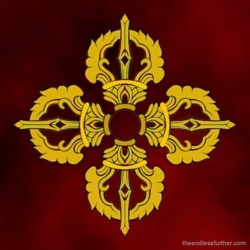Difference between revisions of "Buddhist Symbols"
(Created page with "thumb|250px| <poem> In the earliest centuries of Buddhism, statues of the Buddha were not used. Instead, Buddhist art consisted of images symbolizing the B...") |
|||
| Line 1: | Line 1: | ||
[[File:Vajra5.jpg|thumb|250px|]] | [[File:Vajra5.jpg|thumb|250px|]] | ||
<poem> | <poem> | ||
| − | In the earliest centuries of Buddhism, statues of the Buddha were not used. Instead, Buddhist art consisted of images symbolizing the Buddha and his teachings, such as the lotus, the Wheel of the Law, the Bodhi tree and the Buddha's footprints. | + | In the earliest centuries of [[Buddhism]], statues of the [[Buddha]] were not used. Instead, [[Buddhist]] art consisted of images symbolizing the [[Buddha]] and his teachings, such as the [[lotus]], the [[Wheel of the Law]], the [[Bodhi tree]] and the [[Buddha's footprints]]. |
| − | Eventually, the Buddha image became one of the most popular representations in Buddhism, but these early symbols remain important and are frequently used to this day. They are especially important in Theravada Buddhist countries like Sri Lanka and Thailand. | + | Eventually, the [[Buddha]] image became one of the most popular representations in [[Buddhism]], but these early symbols remain important and are frequently used to this day. They are especially important in [[Theravada]] [[Buddhist]] countries like [[Sri Lanka]] and [[Thailand]]. |
| − | As Buddhism spread, Buddhist symbolism was enriched by the cultures it came into contact with. This is especially true of Buddhism in Tibet, which has developed a rich symbolic tradition. The central symbols of Tibetan Buddhism are the Eight Auspicious Symbols, known in Sanskrit as Ashtamangala (ashta meaning eight and mangala meaning auspicious). The Eight Auspicious Symbols are printed on Tibetan prayer flags, incorporated into mandalas and thangkas, and used in other forms of ritual art. Another important symbol is the Wheel of Life, a symbolic representation of the universe as understood by Tibetan Buddhists. | + | As [[Buddhism]] spread, [[Buddhist symbolism]] was enriched by the cultures it came into contact with. This is especially true of [[Buddhism]] in [[Tibet]], which has developed a rich [[symbolic]] [[tradition]]. The central [[symbols]] of [[Tibetan Buddhism]] are the [[Eight Auspicious Symbols]], known in [[Sanskrit]] as [[Ashtamangala]] ('''ashta''' meaning eight and '''mangala''' meaning auspicious). [[The Eight Auspicious Symbols]] are printed on [[Tibetan]] [[prayer flags]], incorporated into [[mandalas]] and [[thangkas]], and used in other forms of ritual art. Another important symbol is the [[Wheel of Life]], a symbolic representation of the [[universe]] as understood by [[Tibetan]] [[Buddhists]]. |
| − | Other important types of symbolism in Buddhism include colors, especially the five colors of white, yellow, red, blue and green, and symbolic hand gestures called mudras.The articles in this section explore these Buddhist symbols, providing information on their history, meaning and use in Buddhism today. (For an introduction and quick guide to Buddhist colors, see our Chart of Buddhist Color Symbolism.) | + | Other important types of [[symbolism]] in [[Buddhism]] include colors, especially the five colors of white, yellow, red, blue and green, and symbolic hand gestures called [[mudras]].The articles in this section explore these [[Buddhist symbols]], providing information on their history, meaning and use in [[Buddhism]] today. (For an introduction and quick guide to [[Buddhist]] colors, see our Chart of [[Buddhist]] Color [[Symbolism]].) |
</poem> | </poem> | ||
{{R}} | {{R}} | ||
[http://www.religionfacts.com/buddhism/symbols.htm www.religionfacts.com] | [http://www.religionfacts.com/buddhism/symbols.htm www.religionfacts.com] | ||
[[Category:Buddhist Symbols]] | [[Category:Buddhist Symbols]] | ||
Revision as of 03:45, 7 July 2013
In the earliest centuries of Buddhism, statues of the Buddha were not used. Instead, Buddhist art consisted of images symbolizing the Buddha and his teachings, such as the lotus, the Wheel of the Law, the Bodhi tree and the Buddha's footprints.
Eventually, the Buddha image became one of the most popular representations in Buddhism, but these early symbols remain important and are frequently used to this day. They are especially important in Theravada Buddhist countries like Sri Lanka and Thailand.
As Buddhism spread, Buddhist symbolism was enriched by the cultures it came into contact with. This is especially true of Buddhism in Tibet, which has developed a rich symbolic tradition. The central symbols of Tibetan Buddhism are the Eight Auspicious Symbols, known in Sanskrit as Ashtamangala (ashta meaning eight and mangala meaning auspicious). The Eight Auspicious Symbols are printed on Tibetan prayer flags, incorporated into mandalas and thangkas, and used in other forms of ritual art. Another important symbol is the Wheel of Life, a symbolic representation of the universe as understood by Tibetan Buddhists.
Other important types of symbolism in Buddhism include colors, especially the five colors of white, yellow, red, blue and green, and symbolic hand gestures called mudras.The articles in this section explore these Buddhist symbols, providing information on their history, meaning and use in Buddhism today. (For an introduction and quick guide to Buddhist colors, see our Chart of Buddhist Color Symbolism.)
